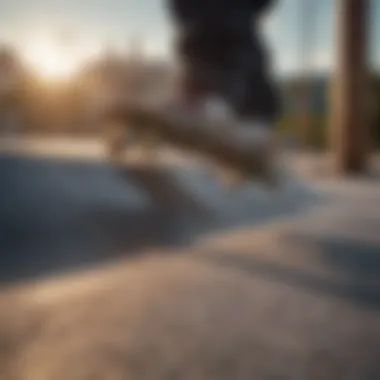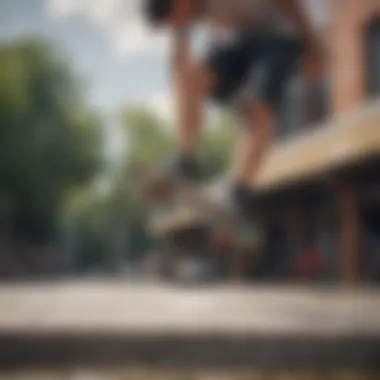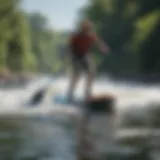Mastering Skateboard Kick Flip Techniques: A Complete Guide


Intro
The skateboard kick flip is one of those tricks that spark fascination among enthusiasts and casual observers alike. It's not just about jumping and flipping the board; it has become a critical skill in the skateboard community. Mastering this technique adds flair to a skater's style and opens the door to more complex maneuvers.
This guide will unpack various aspects of the kick flip. From a technical standpoint to cultural relevance, this article aims for a well-rounded perspective. Our audience—ranging from complete novices to seasoned skaters—will find insights and tips that can refine their execution of the kick flip.
Understanding the Kick Flip
Before diving into technical elements, it’s valuable to grasp what a kick flip entails. At its core, a kick flip involves a vertical flip of the skateboard while the skater is airborne. Executed correctly, this trick reveals the interplay between balance, foot placement, and timing. Whether in a park or on the streets, the kick flip stands as a defining maneuver in a skater's repertoire.
Prelude to Kick Flips
Kick flips represent a fundamental maneuver in the skateboarding catalogue, offering both aesthetic and technical value. As essential tricks, they help riders showcase proficiency and creativity. Understanding kick flips is vital for skaters at any level. Grasping the basics allows newcomers to develop a solid foundation, while advanced practitioners can refine their skills and explore trick variations.
Historical Context
Kick flips have an origin that stems back to the evolution of skateboarding in the late 1970s and early 1980s. The trick originated from other flips and ollies, gaining attention when skaters began experimenting with combinations. Individuals like Rodney Mullen played a crucial role in formalizing the movement; their contributions laid the groundwork for what would become a staple in skate culture.
As skateboarding grew in popularity, so did the emphasis on trick complexity and difficulty. The rise of the global skate community fostered creativity, promoting a culture of exchange where variations rapidly emerged.
Importance in Skateboarding
The significance of kick flips in the skateboard realm is immense. They are not just about style; kick flips symbolizem a rite of passage for many riders. Mastery signals not only capability but also a commitment to the sport. Moreover, they serve as building blocks for more complex tricks. Learning to kick flip helps skaters understand the required pop and flick of their boards, essential for airflow and rotation.
Additionally, kick flips have proven to be adaptable and are present in various of skateboarding disciplines, ranging from street skating to vert. This flexibility enhances their relevance. When breaking down the layers, kick flips reflect both personal skill development and the culture tied to skateboarding, making them a respected element within the sport.
Kick flips are an essential aspect of becoming a proficient skateboarder, serving as a stepping stone toward more advanced skills.
Understanding the Mechanics of a Kick Flip
Understanding the mechanics of a kick flip is essential for skaters aiming to expand their skill set and perform this popular trick effectively. This section will unpack how this knowledge contributes to technique refinement and addresses the various dynamics in play when executing a kick flip successfully. Elements like body mechanics, timing, and movement play significant roles in determining the success of this trick. Familiarizing oneself with these concepts allows for better practice sessions and highlights the trick's potential pitfalls.
The Physics Involved
Physics underpins the kick flip's execution and mastery. Basic principles such as force, momentum, and gravity come into play, influencing the board's flip during the trick. A skater must generate enough upward force through the jump while utilizing the right foot flicking technique to initiate the board's clockwise rotation. The timing of these motions is crucial; if mistimed, skaters may face a lack of rotation or, conversely, a rotation that is too abrupt. Notably, the proper technique includes:
- Jumping: The upward force should utilize the power from the legs, allowing for a sufficient height that will provide time for the flip.
- Flicking the Tail: The placement and motion of the back foot are integral for the kick flip's success. Skaters need to engage enough pressure on the board tail with a flick that directs it into a spin.
- Gravity's Impact: Weight distribution as the board flips aids in maintaining control. A well-timed landing can counteract the forward motion induced by gravity and stabilize a smooth descent.
Ultimately, the skater’s kinetics are finely intertwining in physics, making a coherent understanding of these concepts very significant to mastering the kick flip.
Body Positioning
Correct body positioning is underestimated but is one of the most crucial aspects when learning to kick flip. Skaters need to establish a stable yet dynamic posture suitable for effective flipping. Initially, it is vital to ensure that the feet are positioned correctly on the board. The back foot is commonly placed over the tail, providing force for the flip, while the front foot should rest across the middle of the board at a slight angle. The angle can be a mere ten to fifteen degrees. This specific setup allows the skater to both flick with the back foot and ensure balanced elevation with the front foot.
Additionally, core engagement is vital throughout the maneuver. Skaters should focus on:
- Centered Weight Distribution: Making oneself the balance point, ensures that the remerging of upward and downward forces creates an equilibrium conducive to a stable landing.
- Shoulders Aligned with the Board: This keeps natural alignment, allowing rotational motion for the flip while preparing for proper landings post-flip.
- Knees Flexed: Bending knees helps absorb the impact while allowing a stronger push-off and better board control.
A skater's body positioning affects both the execution and outcome of a kick flip, making continual adjustments necessary as skill level increases.
Remember, success with a kick flip hinges not only on practice but also on understanding how body mechanics contribute to executing the move gracefully. Become aware of these details, and you will find yourself incrementally improving.
Step-by-Step Guide to Performing a Kick Flip
Performing a kick flip is a combination of art and skill. Understanding the procedure is crucial for skateboarders, from beginners to seasoned pros. This guide provides essential information, breaking down the complexities into manageable steps, ensuring skaters can safely and successfully perform this trick.
Preparing Your Skateboard
Before attempting a kick flip, it is important to set up your skateboard properly. Check the following aspects:
- Deck: Ensure your skateboard deck meets your personal width preferences. A comfortable deck width allows ease of foot maneuverability during the trick.
- Trucks: Inspect the trucks for wear; replace them if they are strained, as this can impact performance. Tighter trucks provide stability, while looser ones facilitate easier flip rotations.
- Wheels: Clean the wheels or replace them if needed. Ensure your wheels match your style of riding. Softer wheels can improve grip during flips, while harder wheels help achieve better tricks on smooth surfaces.
Prepare mentally; adding mental readiness offers a sharpening focus, helping in smooth execution.


Foot Placement Techniques
Foot placement is key to a successful kick flip. Improper positioning can lead to improper flip execution or loss of balance. Follow these steps for correct foot placement:
- Back Foot: Position your back foot on the tail of the board. Ensure most of the weight rests on the ball of your foot just below the pivot point.
- Front Foot: Your front foot should be placed diagonally on the board, with the toes just hanging off slightly. This angle helps create the flip motion needed.
- Weight Distribution: Distribute weight evenly, assuring that you do not lean too heavily to one side—this can cause instability.
Understanding your foot placement can transform your skill convergence during attempts, ultimately leading to smoother flips.
Executing the Flip
When everything feels ready and you are set in your stance, begin to initiate the flip. Here’s how:
- Pop the Tail: Apply downward pressure swiftly on the tail with your back foot. This initiates the lift-off from the ground.
- Flicking Motion: As you pop the tail, quickly use your front foot to flick the edge of the skateboard. This is where the kick flip gets its name. The flicking motion must be brisk, aiming to impart a spin onto the board.
- Leave the Ground: As the tail hits the ground, your feet should both rise off the board. Maintain your focus ahead to ensure you land successfully before the flip completes.
- Timing: Synchronization between pop and flick is critical. Too rapid or slow of any motion leads to unattractive landings and possible falls. Aim for a timing that matches topsping and downward flick motion.
Mastering these executing techniques sets one up for success amidst the trials of this trick.
Landing Safely
Safely landing after a kick flip can determine your overall progression. Follow these instructions for a secure landing:
- Watch for the Board: Maintain visual contact with your skateboard as it completes the flip. Awareness prevents untimely landings.
- Feet Positioning: Land with both feet equally weight on the bolts near the trucks. This balances rotational forces as well.
- Cushioning: Bend your knees slightly upon landing to absorb the impact. This method prevents strain on your joints and helps keep stability.
Practicing estimates of your transition impact will guide a well-timed entry on diverse terrains.
With diligence, understanding each aspect within these stages considerably enhances your kicking flipping capabilities. Transitioning such tips into practice refines technique and expands one’s skating horizons.
Common Challenges in Performing Kick Flips
Kick flips are a foundational trick in skateboarding, but attempting them brings various challenges. Understanding these hindrances is vital for mastery and overall improvement. Recognizing potential pitfalls not only helps skaters to refine technique but also builds resilience. Skating often requires repeated attempts and endurance, facing these common challenges head-on significantly enhances the learning process and eventual success.
Overcoming Fear of Falling
One of the primary obstacles when learning to kick flip is the fear of falling. This hesitance can prevent many aspiring skaters from fully committing to the trick. The risk of loss or of physical injury can be intimidating, especially for beginners.
To manage this anxiety, it is essential to establish a comfort zone. Start by practicing on flat ground, where falls are less severe. Building confidence with small steps can lead to positive mental fortitude. Additionally, using protective gear like helmets and pads can lessen fear, allowing skaters to push boundaries more comfortably. It's necessary to remember that falling is part of learning. Accepting this truth can ease anxiety and promote consistent practice.
Inconsistent Rotation
Inconsistent rotation is another challenge frequently faced. For a successful kick flip, the skateboard must flip in a controlled and consistent manner. Many skaters experience situations where the board doesn't flip ideally, leading to either under-rotation or over-rotation.
Techniques to improve this aspect involve refining foot placement and timing. Focus on a solid snap of the tail with the back foot while the front foot angles slightly down. Practice can enhance accuracy in kicking at the correct angle. Using visual guides or watching experienced skaters can provide helpful insights. Focus on gradual improvement rather than expectation.
Troubleshooting Foot Placement Issues
Foot placement can significantly impact the execution of a kick flip. Misalignment can result in undesired results, making it essential for skaters to evaluate their foot positioning continually. Many skaters do not realize the importance of foot placement until facing repeated failures.
For optimal execution, the back foot should be placed near the tail to ensure a potent flick, while the front foot should be spatially aware–in the middle but a little angled toward the nose of the board. Testing varying placements allows skaters to discover what works best for them. Consequently, keeping a steady practice routine without frustration can help develop strong instincts about foot positions during a kick flip. A well-timed skater must have a clear awareness before executing the deft maneuver.
Remember, voila comes with train—continuous efforts lead to master the art of trick performance.
Variations of the Kick Flip
The kick flip is a fundamental trick in skateboarding, but its variations add depth and complexity to the skillset of a skateboarder. These variations not only spice up a skateboarder’s repertoire but also provide new techniques to master. It's essential to understand these variations as they can help improve an individual’s control and creativity on the board.
Nollie Kick Flip
The nollie kick flip involves a front-foot pop instead of the back-foot pop found in standard kick flips. Here, the rider pushes down on the nose of the board with their front foot. The kick of the back foot follows to create the flip. This trick is often perceived as more difficult due to the shift in balance and foot placement.
Advantages of learning the nollie kick flip include:
- Increased Variability: This trick serves as a foundation for other flip variations, offering new ways to combine tricks.
- Flow Transition: The transition from riding into a nollie facilitates smoother tricks connected to other moves for advanced skating.
This variation requires a different mindset from standard kick flips, as success comes not only from technique but also an understanding of your body’s distribution of weight.
Heelflip vs.


Kick Flip
Understanding the difference between a heelflip and a kick flip is crucial for beginners. While both tricks cause the board to flip in a similar manner, the foot motion differentiates them. In a heelflip, the skater uses the heel to initiate the flip, moving their front foot away from the board.
The main aspects to consider include:
- Foot Placement: The foot position differs; make sure to master placement for each flip type.
- Style Preference: Some skaters tend to favor one trick over the other based on their skating style and comfort level.
- Challenge Factor: A heelflip can feel more intuitive based on the skateboarder's familiarity with the fundamentals of flipping and rotating.
Mastering both can enhance overall performance both on rails and in the air, and can be fun to mix in different tic-tacs.
Kick Flip
The 360 kick flip combines the challenge of a kick flip with horizontal rotation, thus requiring advanced balance and timing. A precise pop with the back foot while simultaneously spinning the entire body is crucial here. Many find this trick visually impressive, and nailing it enhances various aspects of their skateboarding capabilities.
Factors to keep in mind:
- Advanced Technique: Dateplanned for when you're comfortable with both standard kick flips and spins.
- Balance: Proper balance and control are needed throughout the rotation.
- Commitment to Trick Execution: Unlike simpler tricks, the 360 kick flip mandates an added layer of concentration while still making it a fun aspect of skating in flowing lines.
If executed correctly, this trick elevates performances across competitions as well as street skating, showcasing the skill and versatility of accomplished skateboarders.
Pro Tip: Always practice variations at lower speeds before attempting them in high-energy situations. This approach allows building confidence first.
The Role of Gear in Kick Flips
The role of gear in kick flips cannot be overlooked. The right equipment has a significant impact on the execution and success of this complex trick. A skateboard is not just a board; it is an assemblage of various components that contribute to performance. Understanding these components will help a skater choose suitable gear and improve their overall efficiency while practicing kick flips.
Choosing the Right Skateboard
The skateboard itself is crucial for mastering kick flips. Not all skateboards are built the same, which affects how a rider interacts with the board. Here are some important elements to keep in mind when selecting a skateboard for kick flips:
- Deck Material: Skateboard decks are typically made from maple, bamboo, or resin. Maple offers great stability, which is preferred for kicks.
- Shape: A flatter deck helps improve balance when flipping. The concave of the deck should also facilitate the pressure needed for a kick flip.
- Width and Length: A wider board can provide more foot space, while a narrower board can heighten maneuverability. Personal preference will play a role in this choice.
- Trucks: Trucks should be sturdy but not overly heavy. Strong trucks enhance the board’s responsiveness which is vital when executing a flip.
Footwear Considerations
Skateboarding shoes need careful consideration because they can impact foot placement and grip. Here are the key aspects that should dictate this decision:
- Grip: The bottom of the shoe should have a solid grip to prevent slipping. Often, skate shoes have special rubber soles designed for better traction on the skateboard.
- Padding: Clear padding around the ankle is essential. This feature adds support, protecting the foot from injuries during attempts.
- Toe Box: A flat and flexible toe area aids in flicking the board accurately when performing a kick flip.
The right gear increases confidence and improves the performance of a skater attempting kick flips.
In summary, a focus on gear plays a pivotal role in the execution of kick flips. By choosing the appropriate skateboard and footwear, you set yourself up for greater success in mastering this impressive trick. Ensuring that your equipment is well-suited for you can enhance both safety and performance.
Practice Techniques for Mastering Kick Flips
Mastering kick flips requires dedication and the right practice techniques. This section offers insight into how targeted, effective practice can lead to success. Focusing on consistent execution and skill refinement improves both confidence and overall performance. Just like any complex skill, frequent practice allows the skateboarding trick to become more instinctive. Here are some methodologies that yield results:
Using A Flat Surface
Practicing on a flat surface is an ideal way to learn the basics of kick flips. This environment reduces variables like varying terrain and obstacles, making it easier to focus on technique. Key points here include:
- Smooth Ground: A flat, smooth surface ensures consistent performance. Obstructions or uneven ground can negatively impact balance and landing.
- Comfort: Beginners feel more at ease when practicing in such a vast, open space. It allows for ample room to fall and recoup without the fear of sudden hazards.
- Video Feedback: Having someone record your attempts or using a mirror helps in observing body positions and foot placements. This feedback will offer opportunities for adjustment.
- Repetition: Focus on 10-20 consecutive attempts in a single practice session, adjusting as needed for better technique.
Incorporating Obstacles
Once the basics are mastered on flat ground, introducing obstacles can offer advanced practice opportunities. Toys and tools such as ramps and rails increase the skill challenge and variations of your execution. Some considerations include:
- Gradual Addition: Start with small objects like curbs or low ramps. This allows the skater to adapt without being overwhelmed.
- Experimentation with Angles: Focusing on how your board interacts with the obstacles aids in understanding physical dynamics at play.
- Adding Height: After mastering lower obstacles, gradually increase height to refine the kick flip further and simulate real environments.
- Healthy Risks: This practice instills confidence in executing tricks among more challenging settings, gradually desensitizing fear of falling.
Mental Aspects of Learning Kick Flips
Learning kick flips is not only a physical task but also a mental one. Mental stamina and focus play a significant role in successfully mastering this trick. While muscle memory will develop with practice, the underlying mental strength can set someone apart from less dedicated skaters.
Confidence is essential in executing a kick flip. This trick often requires a leap of faith, where fear can hinder performance. Skaters may feel apprehensive about landing or falling. However, overcoming this fear can lead to a successful execution. Building confidence comes through understanding the trick on a deeper level, setting achievable goals, and gradually pushing one’s boundaries. Familiarizing oneself with the mechanics and consistently seeing progress brings an increase in self-assurance.
Additionally, visualization supports the mental approach to learning kick flips. It’s a powerful tool that allows skaters to mentally rehearse the movements required. The simple act of picturing the trick can build the connection between thought and execution. Successful athletes often use this practice to enhance their skills. In turn, visualizing success becomes part of the routine. It prepares a skater’s brain and aids in locking in proper techniques before getting on the board.


These elements collaborate to create a holistic approach to mastering kick flips. It is about combining mental focus with the physical aspects of skating. Once a beginner gets beyond the psychological barriers, mastery of the kick flip becomes more attainable.
Building Confidence
Building confidence when attempting kick flips extends beyond mere repetition. It involves small successes and positive reinforcement. New users can set short-term objectives. This could include;
- Making sure to land a certain number of tries in a session.
- Getting consistent foot placement.
- Gradually elevating the difficulty.
Each success creates a stronger foundation for the next attempt. Skaters must accept that falling is part of the learning process. Recognizing each mishap as a learning moment enables skaters to remain composure in the face of adversity.
Moreover, breaking down the technique into manageable steps assists in reassuring oneself. Each clear step can feel more achievable than investing one’s mind solely in the end goal. Over time, these victories help remove some fear and replace it with confidence.
Visualizing Success
Visualization is a mental exercise recommended for many athletes. For kick flips, it involves mentally rehearsing the trick before trying it. This practice can establish a framework in the skater's mind. It engages several senses and can aid muscle memory. Beginners might take moments to close their eyes and picture:
- The setup in foot positioning.
- The initiation of the flick with the back foot.
- The board's rotation.
- The sound of the wheels landing smoothly on the ground.
Visualizing should feel as close to reality as possible. Engaging in this will yield benefits in execution. Successful performances often stem from what is perceived, ensuring that confidence transitions smoothly from visualizing to actually performing.
Using visualization, skaters might find their aimless practice transformed into a well-structured routine, making skateboarding both more productive and enjoyable.
Consistent application of mental focus and visualization can create a steady path toward mastering not just kick flips but other maneuvers as well. Mental practices integrate into the overall learning process for improved outcomes.
Building a Community Around Kick Flips
The essence of skateboarding transcends the individual act of trick execution; it thrives in the camaraderie shared among skaters. Building a community around kick flips can enhance one’s skills while nurturing a supportive environment for practice and improvement. Engaging with others who share an interest can provide encouragement, motivation, and knowledge exchange, all which are crucial to mastering complex tricks like kick flips.
Moreover, a community setting often lowers the intimidation factor, especially for beginners. Watching peers execute the move or providing constructive feedback fosters a culture of learning and growth. When skaters address common challenges collectively, the journey towards mastering the kick flip becomes more manageable, encouraging regular practice without the fear of failure.
These connections play a vital role in skill enhancement. Members can share specific tips that worked for them. This exchange of ideas often leads to innovative approaches that can improve technique.
Finding a Skateboarding Group
Locating a skateboarding group can be an eye-opening experience. Groups provide structured environments for practicing kick flips and help develop arcane skatboarding skills. In these settings, experienced skaters can mentor rookies. They can introduce fresh boarders to the nuances of techniques, such as the angle of the foot and weight distribution needed for a kick flip.
Here are some practical ways to find a skateboarding group:
- Social Media Research: Facebook has various community groups dedicated to skateboarding that can help skaters find local meetups.
- Local Skate Parks: Visiting skate parks is a good way to meet others who share the same interest.
- Skateboarding Classes: Many towns offer lessons. These can naturally form into regular groups. They convene over time and create lasting skate bonds.
As members of a skate community, enthusiasts share not only skills but also experiences that reinforce resilient attitude, contributing a supportive atmosphere where every participant feels valued and empowered.
Online Forums and Resources
In a world where digital connectivity influences every domain of life, it is no different for skateboarding communities. Online forums and resources can bridge gaps between skaters globally. On platforms like Reddit, diverse communities thrive where skaters discuss techniques, like kick flips, answer queries and advice across all skill levels. Members often submit videos of their practice/demo, spurring constructive discussions regarding foot placement and rotation issues.
Additionally, utilizing websites designed for enthusiasts can connect individuals. Here are a few online resources to consider:
- Reddit Skateboarding: A versatile space for discussions, advice, and sharing routines.
- Facebook Groups: Look for groups focused on skateboarding where experiences, videos, and tips are frequently exchanged.
- YouTube Tutorials: Numerous creators publish video explainers on kick flips and other tricks. This first-hand perspective provides visual learning contacts that complements written descriptions.
The digital age fosters endless opportunities for learning and connection. Skaters can participate in varied environments that bolster their kick flip skills and overall proficiency. Building a strong network, whether in person or virtual, lays the foundation for a fulfilling journey in skateboarding.
Epilogue and Future Perspectives
The importance of solid concluding insights cannot be understated in the context of mastering skateboard kick flips. Through understanding the dynamics of this trick, a skater not only enhances their execution but also enriches their entire skateboarding experience. The ability to perform kick flips elevates one’s repertoire, encouraging both creativity and confidence on the skateboard.
Conclusively, this article provided an in-depth look at various aspects crucial to performing the kick flip effectively. This is a pivotal trick within the skateboarding community, often seen as a benchmark for both beginners and advanced skaters alike. Emphasizing comprehensive techniques balances skill with safety, enabling skaters to progress.
Recap of Key Points
- Kick flips originate from a blend of historical technique and modern execution.
- Understanding the physics and body positioning is essential in achieving accuracy.
- Mental aspects such as confidence and visualization play a crucial role.
- Various practice methods can accelerate learning.
- Safety should always remain a priority when attempting any tricks.
The Evolution of Skateboarding Tricks
The progression of skateboarding tricks, particularly the kick flip, reflects broader trends in skate culture. Initially rooted in basic maneuvers, the art of skateboarding has advanced through continuous innovation. Kick flips played an important role in this evolution as skaters began to create more complex variations and tricks built on its foundation.
Investigation into the evolution highlights significant milestones:
- Open Source Influence: Access to video tutorials and global communication has created a generation of skaters who are instantaneously inspired by each other, making learning backlinks around the globe more achievable.
- Influence of Technology: Modern equipment, including advancements in skateboard design and materials, facilitate sharper tricks and lessen the risk of injuries.
- Cultural Appeal: The kick flip and its variations have entered mainstream activism in skateboarding, appearing in competitions and media events, thus growing their significance.
Continued interest in pushing the boundaries of this art offers thrilling perspectives for the future of skateboarding. It suggests that creativity will consistently outstrip limitation, forging paths veiled in innovation.















